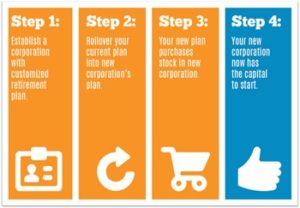Using Retirement Funds to Buy a Business, May 25 GABB Meeting

Larry Carnell, ABI, CBI, CFB, CFE, Vice President of Business Development with Benetrends Financial
Gathering enough cash for a down payment for an SBA loan to buy a business or other business needs can be a challenge. Larry Carnell, ABI, CBI, CFB, CFE, Vice President of Business Development with Benetrends Financial, spoke to the Georgia Association of Business Brokers about how entrepreneurs can use their 401(k), IRA or other qualified retirement account to acquire capital to get approval for an SBA Loan to purchase a business. He also talked about an instant buyer engagement program on how to use cash or retirement funds to help exempt buyers from future capital gain taxes (and proposed increases) and potentially double net inheritance for spouse/children/family.
View a video of the entire meeting on the GABB YouTube channel.
Larry Carnell is a national award- winning entrepreneur and management consultant, as well as a respected business and funding expert at Benetrends. Carnell’s company has programs that allow investors to use part or all of their existing retirement accounts to fund a required down payment for an SBA Loan.
By using long-standing provisions of the Employee Retirement Income Security Act of 1974 (ERISA), Carnell’s company uses a corporate capitalization strategy that enables 100% of the gain on the sale of the company to be tax free. To use this strategy, the business owner rolls over a portion of the funds from a qualified plan or IRA to start a business. When it’s time to sell the business, you may be able to pay no Federal and State tax on any gain from the sale of the business. Up to 100% of the gain can be invested to gro w tax-free, including making an investment in another business, according to Carnell.
w tax-free, including making an investment in another business, according to Carnell.
Carnell also discussed Rollovers as Business Startups or ROBS plan, first introduced by Benetrends Financial as The Rainmaker Plan® in 1983. A ROBS plan is a debt- free funding solution that allows a person to draw from their retirement funds without incurring upfront taxes or early withdrawal penalties. A ROBS plan allows business owners to use their retirement funds, tax-deferred and penalty-free, for the purchase or startup of their business, using a four-step process. He also discussed a Roth Advantage Plan, or RAP.
Advantages of ROBS and RAP plans and similar strategies, according to Carnell, include:
- Increases client engagement (including spouse)
- Superior wealth accumulation & protection (retirement assets cannot be seized by creditors)
- Superior tax benefits (capital gain, income and payroll taxes on retirement contributions)
- Reduces debt and interest payments, Improves cash flow
- Investment NOT a loan – NOT subject to credit rating
- Does NOT adversely impact debt ratios or credit scores
- NOT subject to business profitability
- SBA approved as down payment / equity injection OR used alone
- Improves loan approval rates
- Improves debt ratios Debt free money (SBA approved)
- Improves post close liquidity
- Can be used to leverage BIGGER deal – (Business AND Land) & Broker Fees
- IMPROVES CLOSE RATE
Traditional ROBS features:
- PRETAX use of retirement funds to invest or purchase company stock
- C CORP retirement plan adoption [401(k), hybrid or custom options]
- Retirement Plan BUYS common stock in company
- Company GROWS. Revenues are used to run business. From Profits:
- 401(k) contributions are made NET of payroll taxes (currently 15.3% and rising)
- Rainmaker retirement contributions are EXEMPT from payroll taxes
- Company is SOLD – ‘pretax’ proceeds go into retirement plan
- Proceeds are taxed in the future at future tax rates (expected to rise)
Benetrends offers a NEW Rainmaker/Roth Advantage Plan:
This plan allows business owners to realize the full appreciation of their business tax-free upon the sale of the business, given certain circumstances following the Tax Reduction and Job Creation Act of 2018 (TRJC).
- Cash (minimum of $10k) OR Retirement Funds to invest in company stock
- C CORP creates & adopts 2 CUSTOM retirement plans
- Rainmaker [not a traditional 401(k)] & Rainmaker Roth 401(k)
- Use custom plans to create structure that invests money POST-TAX to BUY common & preferred stock (Taxes due NEXT Year OR 5 year option)
- Company GROWS. Revenues are used for operating expenses
- Retirement contributions are often payroll tax EXEMPT (currently 15.3% and RISING)
- Company SOLD – proceeds forever TAX-FREE & Lifetime protection (no RMDs)
Lenders are finding that these resources are creating enhanced motivation for business ownership, according to Carnell. The perceived security of a job often discourages people from assuming the risks associated with buying or starting a business. When presented, these resources are proving to be effective in helping to engage more borrowers, improve lending approval rates, reduce defaults and leverage larger loans by providing greater access to liquid capital for injection needs, thereby reducing borrowers’ fears while creating dramatic benefits for both the borrower and lender.
Read More

Can Sellers Use Buyer Warning Signs to Their Advantage?

When buyers are looking to make a purchase, the most important step they can take is to perform due diligence on both the business and the seller. And yet, many sellers don’t their due diligence on buyers.
Deals fail all the time. Sadly, this means that all parties lose a tremendous amount of time and effort. Additionally, sellers not only waste time, but often lose money due to business disruptions while working with a prospective buyer.
Let’s look at a few warning signs that might identify a troublesome buyer. The sooner you spot these red flags, the sooner you can avoid potential problems.
Sellers should ask several key questions of buyers:. The list includes:
-What, if any, other businesses have you considered to date?
-How much equity will you be committing?
-Do you have any experience with my kind of business?
Sellers should look for warning signs early on to avoid wasting considerable time. Listen to your gut instincts. If you feel that a prospective buyer isn’t serious and may only be window shopping (or if you feel that the buyer is looking for a far greater deal than you are willing to provide), then simply move on. When you cut your losses early on, this frees you up to focus on prospective buyers that are a better fit.
What if your intermediary informs you that there has been no communication from the prospective buyer after they received the memorandum? Simply stated, this lack of communication could mean that the prospective buyer has changed their mind, or was never that serious in the first place.
Another red flag you might see is when the process is turned over to a junior member of the prospective buyer’s management team. Another is when the prospect doesn’t provide details or information concerning their financial capability to successfully complete the deal. If any of these three red flags pop up, you should consider being proactive. You and your broker might want to reach out to the prospective buyer and ask to meet to discuss the situation.
Warning signs can also occur just prior to closing. Even after the letter of intent has been signed, problems may arise. An inexperienced attorney representing the buyer, one that simply doesn’t understand what is involved in a deal, can doom what could have otherwise been a good deal. The same is true for an over aggressive attorney. One potential remedy for this situation is for your own attorney to intervene and discuss the situation.
Spotting warning signs is about more than not wasting everyone’s time. When you can observe these indicators and act effectively to address them, it can help keep deals on track. Working with a business broker or M&A advisor is an excellent way to not only spot red flags, but also to know how to respond appropriately. The end result will be more successfully completed deals.
Copyright: Business Brokerage Press, Inc.
The post Can Sellers Use Buyer Warning Signs to Their Advantage? appeared first on Deal Studio – Automate, accelerate and elevate your deal making.

SBA Loan Payment Subsidies: Good News for Business Buyers
For business purchasers, there’s good news from the SBA. They’re offering loan payment subsidies for certain loans.
For new SBA 7(a), 504, or microloans approved by SBA beginning February 1, 2021 and ending on September 30, 2021, the SBA will make the monthly payments for a 3-month period. This was originally 6-month period, and this is subject to the availability of funds, according to GABB member Susan Kite, who is also Senior Vice President of SBA Business Development at Georgia Primary Bank.
Loans must be fully disbursed and in regular servicing before the payments can begin. New loans approved by SBA beginning February 1, 2021 and Ending on September 30, 2021 will also have the SBA Guaranty Fee Waived, according to Kite.
“This is a savings of $13,500 on a $500,000 loan, or $31,500 on a Million-Dollar loan, $65,000 on a $2 Million loan, and capped at $4,166,666 loan with 90% guaranty which saves $138,125,” Kite said.
These programs will remain as long as funding lasts, she says.
“Thus, your buyers should treat them as a “bonus” and not rely on them fully when determining cash needs,” Kite advises business brokers.
7(a), 504, and Microloans
Initial Debt Relief Assistance
As a part of the CARES Act, SBA was initially authorized to pay 6 months of principal, interest, and any associated fees that borrowers owe for all 7(a), 504, and Microloans reported in regular servicing status (excluding PPP loans). This debt relief to borrowers was originally dependent on the loan being fully disbursed prior to September 27, 2020 and does not apply to loans made under the Economic Injury Disaster Loan (EIDL) program.
These original provisions were amended on December 27, 2020 through the Economic Aid to Hard-Hit Small Businesses, Non-Profits and Venues Act (Economic Aid Act). The Economic Aid Act revised the eligibility criteria for assistance to include all 7(a), 504, and Microloans approved up to September 27, 2020 even if not fully disbursed. All other provisions for initial debt relief remained the same.
Borrowers need not apply for this assistance. SBA provides this assistance automatically as provided below:
- For loans not on deferment, SBA will make monthly payments based on the next payment due on eligible loans for a total amount equivalent to no more than 6 months of installment payments.
- For loans currently on deferment, SBA will begin making monthly payments with the first payment due after the deferment period ends for a total amount equivalent to no more than 6 months of installment payments.
SBA has notified 7(a), 504, and Microloan Lenders that it will pay these borrower loan payments. Lenders are to report to SBA periodically on the amounts due once a loan is fully disbursed. Payments collected after March 27, 2020 may be applied to the outstanding loan balance or returned to the borrower at the borrower’s discretion.
Additional Debt Relief Assistance
The Economic Aid Act also authorized additional debt relief payments to 7(a), 504, and Microloan borrowers beyond the 6-month period prescribed in the CARES Act. The level of assistance varies based on when the loan was approved and will begin on or after February 1, 2021. Please contact your Lender for questions on the availability of this assistance for your SBA loan.
THE INITIATIVES DESCRIBED ABOVE ARE LIMITED TO THE LEVEL OF AVAILABLE FUNDING PROVIDED BY CONGRESS.
For current SBA Serviced Disaster (Home and Business) Loans: If your disaster loan was in “regular servicing” status on March 1, 2020, the SBA is providing automatic deferments through March 31, 2021.
What does an “automatic deferral” mean to borrowers?
- Interest will continue to accrue on the loan.
- 1201 monthly payment notices will continue to be mailed out which will reflect the loan is deferred and no payment is due.
- The deferment will NOT cancel any established Preauthorized Debit (PAD) or recurring payments on your loan. Borrowers that have established a PAD through Pay.Gov or an OnLine Bill Pay Service are responsible for canceling these recurring payments. Borrowers that had SBA establish a PAD through Pay.gov will have to contact their SBA servicing office to cancel the PAD.
- Borrowers preferring to continue making regular payments during the deferment period may continue remitting payments during the deferment period. SBA will apply those payments normally as if there was no deferment.
- After this automatic deferment period, borrowers will be required to resume making regular principal and interest payments. Borrowers that cancelled recurring payments will need to reestablish the recurring payment.
If you have questions about your current loan and whether or not your loan is automatically deferred, please contact your Loan Servicing Office directly using the following information:
- Birmingham Disaster Loan Servicing Center:
- Phone: 800-736-6048
- Email: BirminghamDLSC@sba.gov
- El Paso Disaster Loan Servicing Center:
- Phone: 800-487-6019
- Email: ElPasoDLSC@sba.gov
Read More

Buying and Selling Businesses in a Pandemic: GABB Feb. 23
Despite the challenges posed by the pandemic in 2020, many Georgia business brokers continued to sell more than a million dollars worth of businesses. GABB board member Tanya Nebo and six members of the GABB Million Dollar Club offered a wide variety of advice on Tuesday, Feb. 23, during a panel discussion of how to buy and sell businesses during a pandemic.
To view their comments on how they prospered in 2020, watch this video posted on GABB’s new YouTube channel.
Among the 2020 members of the GABB’s Million Dollar Club who will be on hand on Feb. 23 are Jefffery Merry, senior business analyst at the BUSINESS HOUSE, inc.; J. Snypp, Vice President of Preferred Business Brokers, Inc.; Matt Wochele, founder of Preferred Business Brokers, Inc.; Rob Margeton, an M&A Intermediary with Ryco Advisors, LLC; Brian Judson, a business broker with Best Business Brokers; and Jon Roman, business intermediary, franchise consultant and developer at Transworld Business Advisors.
Ms. Nebo is both a business broker and an attorney. Her law practice, real estate agent and business brokerage services focus on commercial real estate, franchising and general business matters (including joint ventures and equity participation models). She is a graduate of Columbia University in New York and the University of Virginia School of Law.
The GABB is the state’s premier association of professionals who help in the purchase and sale of businesses. GABB is committed to promoting professionalism, education and high ethical standards in the profession of business brokering.
For more information, contact GABB President Judy Mims at 404-842-1997 or judy@childcare.properties, or Ms. Loupe at diane.loupe@gabb.org or 770-744-3639.
Read More
Why Businesses Get Into Trouble
No two companies are quite alike, and this also means that there are many reasons why companies can fall into trouble. While the number of variables involved in operating a company are practically endless, there are a handful of reasons why companies can fall on hard times. Let’s take a closer look.
Lacking Focus
Companies that lack focus can often run into considerable trouble. Not understanding their customers and what they need or want can lead to endless problems. It is vital that companies frequently stop and assess who their customers are and whether or not they are properly servicing their needs.

Photo by Andrea Piacquadio from Pexels
Management Problems
Not too surprisingly, many companies can run into trouble because of poor management. Management problems are not one-dimensional, but instead take a variety of shapes. Management that isn’t focused, is incompetent, or simply doesn’t care about the business can translate into a business’s premature death.
Under the umbrella of “management problems” also falls such missteps as poor financial controls, quality control problems, operational issues, and/or not keeping up with technological advancements. At the end of the day, many of the problems on our list have at least some management issue missteps at their heart.
Loss of Key Employees or Clients
The loss of a key employee or a key client can spell serious trouble. Of course, no management team can predict every eventuality. However, when there is a loss of a key employee or client, and there is no plan for replacement, then management does shoulder at least some of the blame. The savviest companies take steps to ensure that there are ways to replace the most important employees and clients.
Failure to Compete
More than one business has been buried by the competition or failure to see a new wave of competition coming. For example, countless mom and pop video rental stores were absolutely bludgeoned by the introduction of Blockbuster Video a generation ago.
While it is true that sometimes market forces are so aligned against a business that survival is almost impossible, that is normally not the case for most businesses on a year-to-year basis. The most effective and competent management can see the competition out on the horizon. Or at bare minimum, they have an emergency plan in the event that the competition becomes more intense.
All too often by the time a business realizes that it is in trouble, it is already too late. If the problems can’t be fixed, then it may be time to consider selling the business. But such decisions must be made quickly in order to prevent additional bloodletting.
Optimally, a business is sold while it is doing well. Regardless of whether a business is thriving or experiencing difficulties, a business broker or M&A advisor can be an invaluable ally in helping a business reach its full potential.
Copyright: Business Brokerage Press, Inc.
The post Why Businesses Get Into Trouble appeared first on Deal Studio – Automate, accelerate and elevate your deal making.
